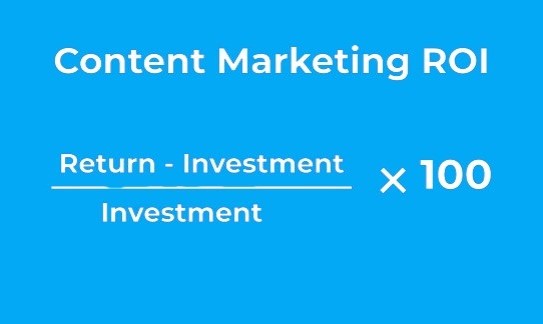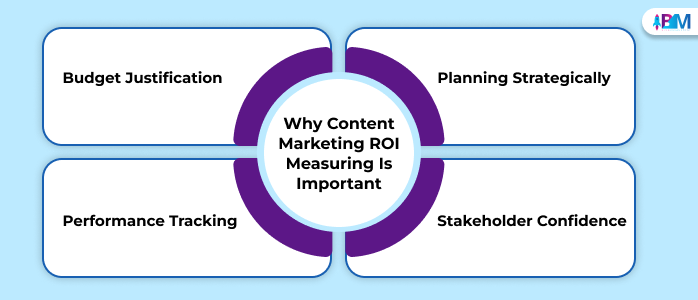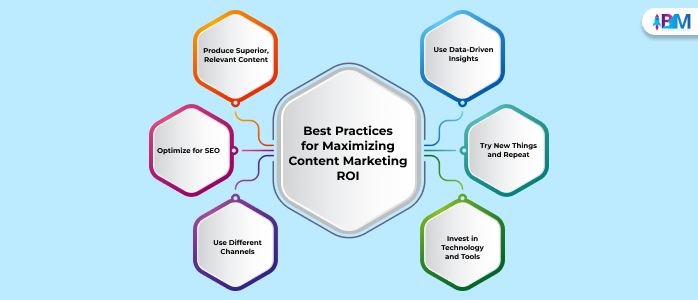In the present competitive world of content marketing, increasing visibility and promoting online presence are vital factors to stay ahead of the competition. Here in, calculating your return on different content marketing efforts is paramount. However, despite their importance, calculating the return on investment or ROI is challenging for many businesses.
Understanding and quantifying ROI is critical for showing the value of content marketing projects, gaining resources, and optimizing strategies. ROI offers a clear picture of campaign performance by comparing financial rewards to content creation and distribution costs.
This thorough guide explores effective methods for calculating the return on investment (ROI) of your content marketing campaigns, assisting you in making choices and getting the most out of your financial commitments.
Matching your ROI measurement with your goals, which may include producing marketing qualified leads (MQLs), boosting traffic, and increasing social media engagement, can help you better understand the effects of your marketing.
What Is Content Marketing ROI?
A content marketing return on investment (ROI) is the amount of money made from these efforts divided by the expenses of creating and distributing the content. In other words, it answers the question, “How much revenue did our content marketing initiatives earn?”
For content marketing ROI calculations, use the following formula:

Businesses may use this method to assess their content marketing initiatives’ financial return on investment and make informed decisions.
It’s not that easy, of course, like everything in marketing. A content marketing campaign’s return and investment are determined by several factors, some of which can be measured and others of which cannot.
Why Content Marketing ROI Measuring Is Important

Your business must have Content Marketing ROI for the following reasons:
- Budget Justification: Content marketing’s budget is justifiable when it proves a good return on investment, making it easier to secure more funding for other projects.
- Planning Strategically: This lets marketers optimize their strategies and focus on what works best by showing them which types of content and channels have the highest ROI.
- Performance Tracking: Periodic measurement of this helps in tracking the progress of various content marketing campaigns over time and ensures continued growth.
- Stakeholder Confidence: The demonstration of ROI builds trust among stakeholders regarding content marketing effectiveness including executives, investors, and customers.
Important Metrics For Calculating Content Marketing ROI
Here are the best 5 important metrics for calculating content marketing ROI.
1. Traffic Metrics
Metrics on traffic are essential for determining how successfully your content draws readers. Page views, average time on page, traffic sources, and website traffic are important indicators. While traffic sources pinpoint the origins of these visitors, website traffic counts the number of visits.
The overall number of pages visited is measured by page views, and the average time spent on a page tells you how interesting and pertinent your content is to your audience.
2. Metrics Of Engagement
Metrics related to audience engagement assist in assessing how successfully your content is interacted with. Bounce rate likes and shares on social media, and comments and conversations are all significant measures.
Likes and shares demonstrate the popularity of the content, whereas the bounce rate displays the percentage of visitors that leave after only one page.
The efficacy and relevancy of the content are shown through comments and interactions, which also show the degree of audience participation.
3. Metrics For Conversion
To evaluate how well your content is influencing desired behaviors, conversion metrics are crucial. Moreover, lead generation, rate of conversion, and revenues are important KPIs. While conversion rate shows the proportion of visitors who complete a targeted activity, lead generation counts the quantity of leads generated.
Additionally, sales analytics provide you with a clear view of the financial effect of your content marketing by tracking the revenue from leads or sales that were impacted by your content.
4. Metrics Of Cost
Understanding the financial commitment made in content marketing requires a grasp of cost indicators. The expenses associated with creating and distributing information are important measures.
The costs associated with creating content include writer, designer, and production fees. Content distribution costs include costs associated with content promotion, such as paid posts, email marketing, and ads on social media. Monitoring these expenses ensures a healthy return on investment.
5. Metrics For Customers
Customer analytics give information about the long-term worth of content marketing initiatives. Customer lifetime value (CLV) and customer acquisition cost (CAC) are significant measures.
While CLV calculates the overall income a business might anticipate from a single client over time, CAC assesses the entire cost of gaining a new consumer through content marketing.
Effective Steps To Boost Content Marketing ROI
Here is a step-by-step guide to achieving your content marketing ROI goals:
Step 1: Set Clear and Achievable Goals
Firstly, establish specific, quantifiable objectives for your content marketing campaigns.
These objectives, which include raising website traffic, growing sales, generating leads, or improving brand awareness, should align with your overall business goals.
Setting these objectives will provide you with a guide for assessing the effectiveness of your content.
Step 2: Analyze And Optimize
Track and gather information on the most important metrics previously stated by using analytics solutions like Google Analytics, HubSpot, or SEMrush.
Ensure you have appropriate tracking systems to link content pieces to sales and conversions. By regularly tracking this data, you can determine which content appeals to your audience the most.
Step 3: Determine Expenses
Determine the expenses related to your content marketing campaigns with accuracy.
This covers direct and indirect expenses, such as software subscriptions and marketing team member wages, and direct expenditures, such as content development and delivery.
A comprehensive breakdown of these expenses is necessary to make a reliable ROI calculation.
Step 4: Revenue Attribution
Calculate the money that comes in from your content marketing efforts.
Although it might be difficult, techniques like CRM data, first—and last-touch attribution models, and UTM parameters can assist in connecting revenue to certain content pieces.
By implementing these strategies, the financial effect of your content will become more evident.
Step 5: Use The ROI Formula
Find your content marketing campaigns’ return on investment (ROI) using the previously given formula.
To find the total profitability of your efforts, compare the revenue generated with the expenses paid.
Best Practices For Maximizing Content Marketing ROI

By following these best practices for maximizing ROI, you can fully realize the potential of your content marketing campaigns.
1. Produce Superior, Relevant Content
Each effective content marketing plan starts with relevant, high-quality content. Concentrate on producing content that adds value, speaks to the wants and requirements of your target market, and establishes your company as an authority in the field. Keep your content updated and fresh to keep it valuable and relevant.
2. Optimize For SEO
Getting organic traffic to your content mostly depends on search engine optimization or SEO. Ensure that your content complies with best practices for both on-page and off-page SEO, is optimized for relevant keywords, and has alt tags and meta descriptions. Stay updated with algorithm upgrades and SEO trends to keep your search rankings robust.
3. Use Different Channels
To increase your content’s impact and reach, distribute it across various platforms. These can include your page, blog, social media pages, website, email newsletters, and websites operated by others.
Customize your content for each channel to engage your audience effectively. Moreover, use channel-specific statistics to fine-tune your distribution strategy.
4. Use Data-Driven Insights
Use data and analytics to guide your content marketing approach. Evaluate performance indicators regularly to determine what is and is not working.
Then, use data to inform your decisions in order to maximize your content and distribution efforts. Establish recurring reports to monitor your goals’ success.
5. Try New Things And Repeat
Iteration and experimentation are continuous processes in content marketing.
Try different kinds of content distribution methods, concepts, and types to find what appeals to your audience the most.
Make ongoing adjustments to your plan based on the knowledge you’ve gathered from these experiments. Track your results to create a knowledge base for future tactics.
6. Invest In Technology And Tools
Invest in the appropriate technology and tools to make your content marketing campaigns go more smoothly.
Enhancing efficiency and efficacy may be achieved through analytics tools, SEO software, marketing automation platforms, and content management systems (CMS). Regularly assess new tools to remain up-to-date with technical developments.
Conclusion
Measuring the return on investment (ROI) of content marketing requires more than just numbers; it also involves recognizing the value that your content adds to your company and taking strategic actions to increase that value.
Establishing clear targets, monitoring pertinent indicators, precisely estimating expenses and income, and consistently refining your approach can help you prove the efficacy of your content marketing efforts and achieve notable business growth.
Remember that content marketing is an ongoing commitment, with the actual return on investment frequently becoming visible as your company gains credibility and trust in the industry. Thus, remain committed, keep trying new things, and see the long-term results of your content marketing efforts.
Read Also:
